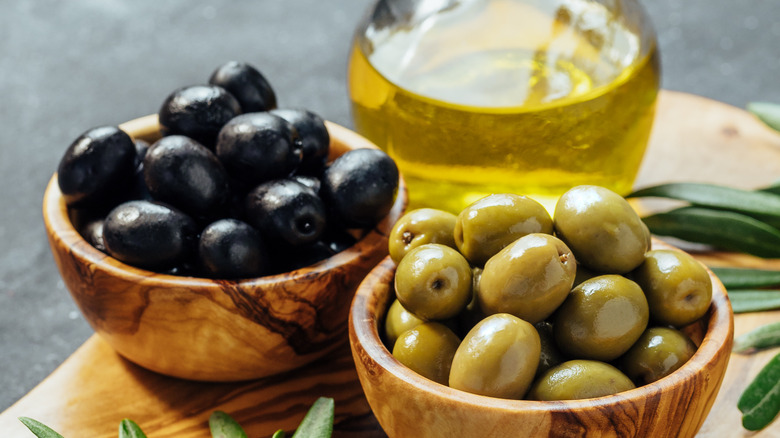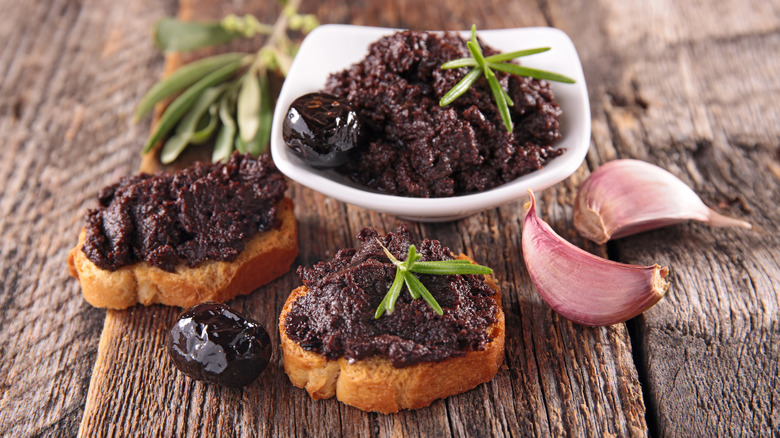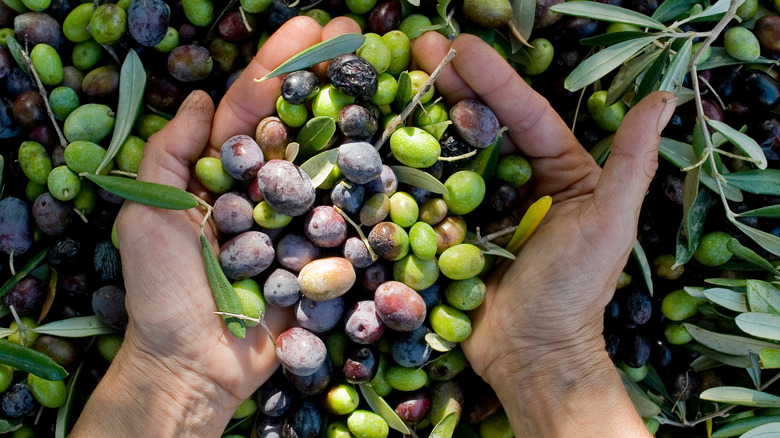What's The Difference Between Black Olives And Green Olives?
The only times you regularly encounter olives may be in a martini or atop a plate of nachos. But the world of olives is vast and intriguing, dating back to the ancient Mediterranean region. Olive Oil Times reports that evidence of olive consumption has been discovered in the area dating back as far as 790,000 years ago! Their fruits have long been eaten as a healthy food, and olive oil provided fuel for lamps and supported the economy of ancient Greece and Rome, says FoodPrint.
Today, the love and demand for olive oil continue to grow, with a global market worth over $13 billion in 2021, according to Fortune Business Insights. This surge in popularity is due to an increasing interest in healthy cooking and lifestyles. There are many types of olives — over 2000 varieties — but around 90% of the world's olive crop, primarily produced in Spain, goes into olive oil (per National Geographic). That means that the remaining are consumed as "table olives," and most of us just know either the green kind that comes in a jar, often stuffed with a red thing (more on that later), or the pitted black kind that comes in a can. Here's the rundown on black olives versus green olives and how to use them in your kitchen.
Black olives aren't really black
Black olives are clearly intended to be put on the ends of your fingers and relished one by one. They might be marketed as "ripe California olives" since most of the United States' olives come from the Golden State (via National Geographic). But believe it or not, they're actually unripe olives that have undergone a process to change their skin to a uniform color while artificially ripening them. The idea came from an Oakland woman named Freda Ehmann in the 1890s (per Marketplace). Initially, black olives were sold in jars until botulism outbreaks forced the industry to switch to cans.
These days, pitted black olives are essential ingredients for the restaurant industry, valued for their convenience and the agreeable taste and texture they bring to everything from salad to pizza and Tex-Mex cuisine, according to Webstaurant Store. Black olives are slightly sweet and help balance the bitterness of green olives in a rich tapenade. New York Times Cooking sings the praises of black olives paired with cauliflower. But really, there's no need to get fancy — black olives are a delicious snack straight out of the can.
Green olives aren't edible naturally
Green olives, also called "Spanish olives," are still sold in glass jars. Medium explains that olives picked fresh from the tree are inedible. Therefore, they're harvested when green and immature and then cured — usually with lye and a brine (via National Geographic), which adds an intensely salty dimension to their naturally bitter taste. Green olives often come stuffed with pimento (a sweet red pepper), but you may find them filled with garlic cloves, cheese, anchovies, and more.
And what about the purple ones? They ripen on the tree and develop anthocyanin, the same stuff that gives red vegetables and blueberries their color.
Black or green, FoodPrint reminds us that olives are loaded with monounsaturated fat (the PR-friendly kind) and vitamin E. Healthline also underscores their high antioxidant and mineral content — just watch the sodium. It seems like the only downside to olives is finishing what you started. BBC Good Food suggests several handy uses for the inevitable leftover fridge olives — we feel called out but also inspired. Try using green olives in pasta and chicken dishes, on a charcuterie board, or eating them plain — no judgment here.


